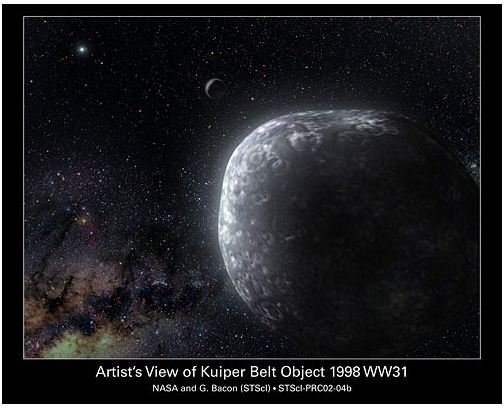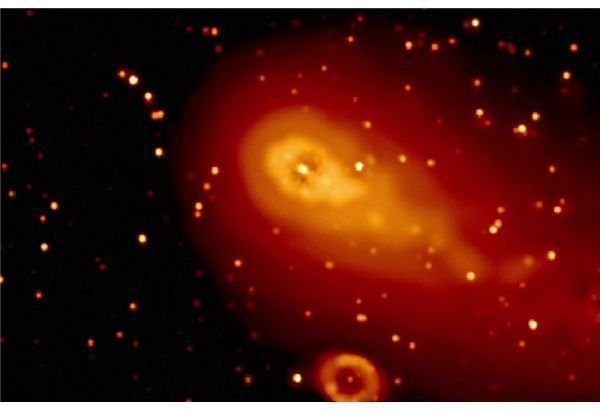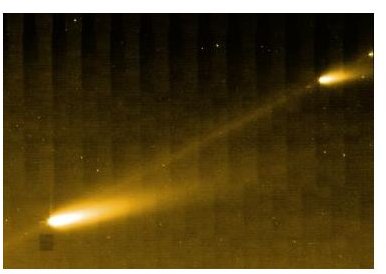Learn About, What is a Short Period Comet
A Brief Review of Comets
To answer the question, “What is a short period comet?” we have to understand the characteristics of a comet. Comets are small planetary bodies usually just a few kilometers in length and made up of volatile ice, rock, frozen gases and dark organic compounds. Comets form from materials left over from the creation of the Solar System, over 4.6 billion years ago.
In deep space, comets are frozen solid but as they get closer to the inner Solar System and the Sun, the intensity of the sunlight causes
some of the frozen ice to melt and evaporate from its nucleus (core). These vaporized gases, along with dust particles will shoot from the side of the comet facing the Sun and cause a fuzzy atmosphere or coma to form around the comet. According to NASA, the diameter of the coma can stretch out for hundreds of thousands of kilometers. Solar radiation and solar winds, blows the coma material away from the Sun, causing an ionized gas tail (from the solar wind**)** and or a dust tail (from the solar radiation) to form. The World Fact Book at NASA states that some tails can stretch out for millions of miles in space.
The materials forming the coma will reflect sunlight; energy released by ionized gases will also contribute to the comets glow - the majority of the shine however is due to the reflected sunlight. The luminosity can be so bright in some comets that they become visible from Earth and create a spectacular display in the sky.
Comparing Long and Short
Essentially all comets are composed of the same materials, but they are defined as short period or long period comets, a classification that reflects the length of time it takes a comet to complete one rotation around the Sun.
Long period comets, take longer than 200 years to complete their orbits, in some cases, these orbits can take millions of years! Ecliptic or short period comets, on the other hand, complete their orbits in less time and have mostly predictable orbits. Like the planets, most short period comets complete prograde orbits around the Sun.
Most long period comets are thought to originate from the Oort Cloud, a dense spherical bubble surrounding the entire galaxy and containing trillions of icy bodies. The Oort Cloud, is hypothesized to lie around 50,000 astronomical units (AU), about 4.6 trillion miles from the Sun. The outer edges of the Oort Cloud are at the fringe of the Solar System and may extend out to 200,000 AU (18.6 trillion miles). At this vast distance, objects are only weakly bound to the Sun and move very slowly. Interactions with passing stars, giant molecular clouds, the occasional collision, and tidal pulls from the Milky Way Galaxy’s galactic disc (and galactic core) can disturb the orbits of these comets and send them into the inner Solar System.

Arguably, the most well known long period comet is that of Hale-Bopp. Discovered in 1995, the comet first became visible to the naked eye in 1996 as it approached its perihelion, its nearest distance to the Sun. It will take around 2500 years for the comet to reach this point again.
Understanding Short Period Comets
Short period comets originate from the Kuiper Belt and a subset of the belt called the scattered disc. The Kuiper Belt is a region of space out past Neptune best described as a doughnut shaped grouping of many small icy objects. The dwarf planet Pluto is among the thousands of objects found here. The Kuiper Belt starts at approximately 30 AU (2.8 billion miles) and extends to 50 AU (4.6 billion miles). Comets in the Kuiper Belt are thought to experience roughly stable orbits that are disturbed by the large gas giants of the outer Solar System.
The scattered disc is a sparsely populated area that overlaps the Kuiper Belt but extends much further out, specifically; objects in the scattered disc are no closer than 35 AU (3.2 billion miles) from the Sun but can go beyond 100 AU (9.3 billion years). Scattered disc objects are made up of small bodies like the dwarf planet Eris. Comets in the scattered disc are thought to have originated in the Kuiper Belt but escaped the region due to the gravitational pull caused by the large gas planets migrating outward to their current positions, a process that took hundreds of millions of years.
The gravitational force of the gas planets and Neptune in particular, causes these comets to have eccentric orbits and a great range of inclinations as they revolve around the Sun. The majority of short period comets are believed to originate here rather than from the Kuiper Belt.

Two Subclasses of Short Period Comets
The question of “What is a short period comet?” can be further divided into two subcategories, Jupiter family and Halley family comets. Jupiter family comets, likely originate in the Kuiper Belt - such comets take less than 20 years to rotate around the Sun. The massive gravitational force exerted by Jupiter locks these comets into a comparative orbit with the planet.
The fastest moving short period comet is Encke. The small comet has a nucleus of less than 5 kilometers in diameter and speeds around the Sun in 3.3 years. The annual Taurid meteor show is caused by Earth moving through a dust trail associated with the comet. Comet Grigg-Skjellerup is another well known Jupiter family comet, the comets nucleus measures less than 3 kilometers in diameter and completes an orbit every 5 years.

The Halley family of comets features those with intermediate periods, taking between 20 to 200 years to orbit the Sun. Many of these comets may have originally been long period comets originating from the Oort Cloud that were pulled into the inner Solar System by the gravity of the gas planets. The most well-known short period comet is Halley’s Comet. Halley has an orbit that takes about 76 years to orbit the Sun. At its farthest, the comet is 3.3 billion miles from the Sun; NASA states that as it approaches the Sun, its coma becomes bigger than Jupiter! The comet was observed by ancient astronomers as early as 240 BC and should appear again in 2062.
References
About Oort Cloud (https://www.bbc.co.uk/solarsystem/other_solar_system_bodies/oort_cloud)
The Kuiper Belt (https://www.windows2universe.org/comets/Kuiper_belt.html)
Solar System Exploration: Comets (https://solarsystem.jpl.nasa.gov/planets/profile.cfm?Object=Comets&Display=OverviewLong); (https://solarsystem.nasa.gov/planetselector.cfm?Object=Comets)
Solar System Exploration: Kuiper Belt & Oort Cloud (https://solarsystem.nasa.gov/planets/profile.cfm?Object=KBOs)
World Book at NASA (https://www.nasa.gov/worldbook/comet_worldbook.html)
Image Sources
Artist’s View of Kuiper Belt Object. (Photo by NASA Goddard Space Flight Center (NASA-GSFC); https://nix.larc.nasa.gov/info;jsessionid=11dguanlx0w4h?id=GL-2002-001140&orgid=6)
Charge and Exchange. (NASA Goddard Space Flight Center (NASA-GSFC);
https://nix.larc.nasa.gov/info;jsessionid=2f2vgabhkdt35?id=10587&orgid=6)
Comet Stepping Stones. (NASA Jet Propulsion Laboratory (NASA-JPL); https://nix.larc.nasa.gov/info;jsessionid=d5vke4i0krot?id=PIA08438&orgid=10)
Hubble Images of Comet Hale-Bopp. (Photo by NASA Jet Propulsion Laboratory (NASA-JPL); https://nix.larc.nasa.gov/info;jsessionid=11dguanlx0w4h?id=PIA01289&orgid=10)
